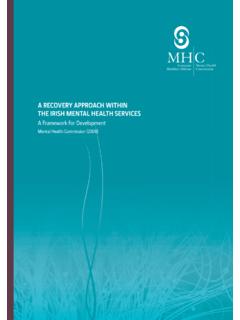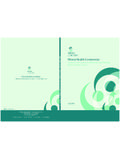Transcription of Multidisciplinary Team Working: From Theory to Practice
1 Multidisciplinary team working : From Theory to PracticeDiscussion Paper ..fosteringand promotinghigh standards in the delivery of mental health Multidisciplinary TeamWorking: From Theory to PracticeDiscussion PaperMental Health Commission January 2006 Discussion Paper1 Chapter One Introduction3 Chapter TwoRationale, definitions and benefits ofmultidisciplinary team working9 Chapter ThreeFactors which influence effective Multidisciplinary team working15 Chapter FourCore competencies for Multidisciplinary team working19 Chapter FiveMembers of the Multidisciplinary team25 Chapter SixModels of Multidisciplinary team working33 Chapter SevenIssues in Multidisciplinary working39 Chapter EightThe next step issues and questions to consider49 References53 Appendix 1 Example of Multidisciplinary team working from Australia60 Appendix 2 Possible referral pathway to Multidisciplinary team63 Appendix 3 The Royal Australian and New Zealand College of Psychiatrists (Position Statement No. 47)64 Appendix 4 Template for team discussion65 Multidisciplinary team working : From Theory to Practice2 Table of contentsChapter Group - Terms of ReferenceOne of the statutory functions of the Mental Health Commission is to foster andpromote high standards of care and best Practice in the delivery of mental healthservices.
2 In pursuit of this aim, the Commission has formed a number of workinggroups to examine complex issues in mental health, with a view to preparing a seriesof discussion documents. These discussion documents will then be circulated toindividuals and organisations with a stake in mental health services in order togenerate an informed debate and discussion around the specific topic. TheCommission will then produce a definitive document on the topic in question,presenting guidelines for mental health treatment and paper on Multidisciplinary team working is the second discussion paper to beproduced as part of this process. This is the first step for the Mental HealthCommission in producing a definitive statement on Multidisciplinary team working toguide mental health service development in of referenceThe terms of reference for the group were: On behalf of the Mental Health Commission, the working group is to reviewthe available literature and models of Multidisciplinary team working and,based on best Practice and available evidence, to present different models formultidisciplinary team working and pose questions as to which model mightbe most suitable for Irish mental health services.
3 Questions should also beposed on other issues around Multidisciplinary team working . Multidisciplinary team working : From Theory to Practice41 Chapter 1: the sceneSome 20 years ago Planning for the Future(Department of Health, 1984)recommended the establishment of Multidisciplinary teams as different approachesto treatment, and the participation of people from a number of professionaldisciplines are required to cater adequately for the needs of the mentally ill . Itrecommended that, as well as psychiatrists and psychiatric nurses, psychologists,social workers and occupational therapists should form psychiatric teams toprovide comprehensive treatment and care for the mentally ill. One of the four guiding principles of the Health Strategy Qualityand Fairness: AHealth System for You (2001) person-centeredness, describes very well the centralaim of providing mental health care through a Multidisciplinary team . A person-centred health system is described in the Health Strategyas one which identifiesand responds to the needs of the individual, is planned and delivered in a co-ordinated way, and helps individuals to participate in decision making to improvetheir health.
4 Mental health services have been to the fore in providing this type ofperson-centred care for some starting point is the individual using a mental health service. Individuals withmental health problems often have a wide range of needs that may be social andpsychological. In various recent consultation exercises, service users and their carershave made known their views on mental health services, and what they consider tobe high quality mental health services (Mental Health Commission, 2005; ExpertGroup on Mental Health Policy, 2004a&b). They wish to have access not just todoctors and nurses, but to psychologists, social workers, occupational therapists andother therapists. They want access to the range of interventions offered by thisvariety of mental health professionals. A key strength of Multidisciplinary teams isthat the combined expertise of a range of mental health professionals is used todeliver seamless, comprehensive care to the individual. The research evidencesupports Multidisciplinary team working as the most effective means of delivering acomprehensive mental health service to people with mental health problems,especially those with long-term mental health problems (Tyrer, 1998).
5 The benefits ofmultidisciplinary team working for both service users and providers are wellestablished and are outlined in Chapter Paper15In spite of the support for Multidisciplinary team working from health policy andservice users, there are surprisingly few Multidisciplinary teams in adult mental healthservices. In contrast, Multidisciplinary team working has been the model for workingin child and adolescent mental health services for many years now. While there are asmall number of adult mental health services with well functioning multidisciplinaryteams, this has not happened to any great extent nationally (Mental HealthCommission, 2005b). There are many barriers to effective Multidisciplinary teamdevelopment and functioning. The explanation that is offered most frequently is thatthere are too few mental health professionals in the areas of psychology, social workand occupational therapy to create effective Multidisciplinary teams. The otherexplanation is the omnipresent lack of resources.
6 While there is undoubtedly anelement of truth in these two explanations they have been overcome in someservices. A number of effective teams have been established around the country,some of which are in services that are very poorly resourced. There are other barriersto Multidisciplinary working which are not as easily articulated, such as professionalrivalry and mistrust, lack of support for team working from key professionals andmental health managers/administrators, confidentiality issues, increased risk, lack ofknowledge of what other mental health professionals do and what unique skills theyhave to offer. Lack of training in team working is also a significant barrier to effectiveteams. All mental health professions are educated and trained separately, at bothundergraduate and postgraduate level. These barriers have been well documented inthe literature and are discussed in Chapter Three. These are the real barriers tomultidisciplinary team development, and none are insurmountable.
7 It is unrealistic towait until all members of the ideal Multidisciplinary team are in place before thingscan change. Change can start now if there is sufficient commitment and vision inindividual mental health services to make it purpose of this discussion paperThe aim of this discussion paper is to provide information on Multidisciplinary teamsand how they work, to present the core competencies for Multidisciplinary teamworking (Chapter Four) and different models of Multidisciplinary team working (Chapter Six), to present some of the main issues around Multidisciplinary teamworking (Chapter Seven), and in the context of this information, pose questions toprovoke discussion among all stakeholders. This paper sets out a vision of how Multidisciplinary teams should work in mentalhealth services, and presents a new way of working that is challenging. The MentalHealth Commission is very aware that this is an evolving process and that servicedelivery may change in the coming years so that this discussion paper will need to bereviewed in the medium term.
8 It is not envisaged that this is how things will be formultidisciplinary teams for the next 20 years. We are also aware of the need to adaptthe structure and functions of a Multidisciplinary team according to local needs andcircumstances, and so this discussion paper is not overly team working : From Theory to Practice61 Discussion scope of this discussion paperThis discussion paper discusses mental health Multidisciplinary teams deliveringsecondary level mental health treatment and care, primarily from the perspective ofadult mental health teams. The research undertaken in preparing this paper revealedthat Multidisciplinary teams are in different stages of development in the differentmental health specialties in Ireland. For example, Multidisciplinary team working ismore developed in child and adolescent mental health services. This discussion paperdoes not presume that one size fits all in terms of Multidisciplinary working inmental health services. Instead, this paper presents different models ofmultidisciplinary working , and presents a range of issues that are of relevance andinterest to all mental health services.
9 The Mental Health Commission believes that themultidisciplinary team should be the central component in the delivery of all mentalhealth services, in all specialties. This discussion paper is the first step in preparingnational guidance in this area to achieve this vision. audienceThis report is addressed to all mental health professionals and all those involved inproviding mental health services, including the Department of Health and Children,the Health Service Executive, voluntary groups in the mental health area, theindependent sector, service users and carers; in short, all individuals andorganisations with a stake in mental health team working : From Theory to Practice81 Chapter for Multidisciplinary team workingSince the 1950 s mental health care has moved from the mental hospital tocommunity based care. This movement was the result of improvements inpharmacological treatments along with key social, political and economic included increasing emphasis on human rights, understanding of thedetrimental effects of institutionalisation, the involvement of family and service userorganisations, value for money, and the influence of the therapeutic communitymovement.
10 The latter emphasised the social determinants of mental illness stressingthe role of relationships in treatment (Burns, 2001). The general aims of deinstitutionalisation were to prevent inappropriate mentalhospital admissions through the provision of community based alternatives fortreatment; to discharge to the community all those in institutions who had beengiven adequate preparation for such a change; and to establish and maintaincommunity supports for people receiving mental health services in the community(Bachrach, 1977). As these community services developed there was a fundamental change in theperception of the service user. They began to be seen in the context of their family,their work and leisure pursuits, as members of their neighbourhood and the widercommunity. It became essential to form a working alliance with the user and theirfamilies and to prioritise their concerns. Increasing knowledge of the course ofmental illness and recovery made it clear that the psychological concerns and socialenvironment of the service user needed to be addressed.


